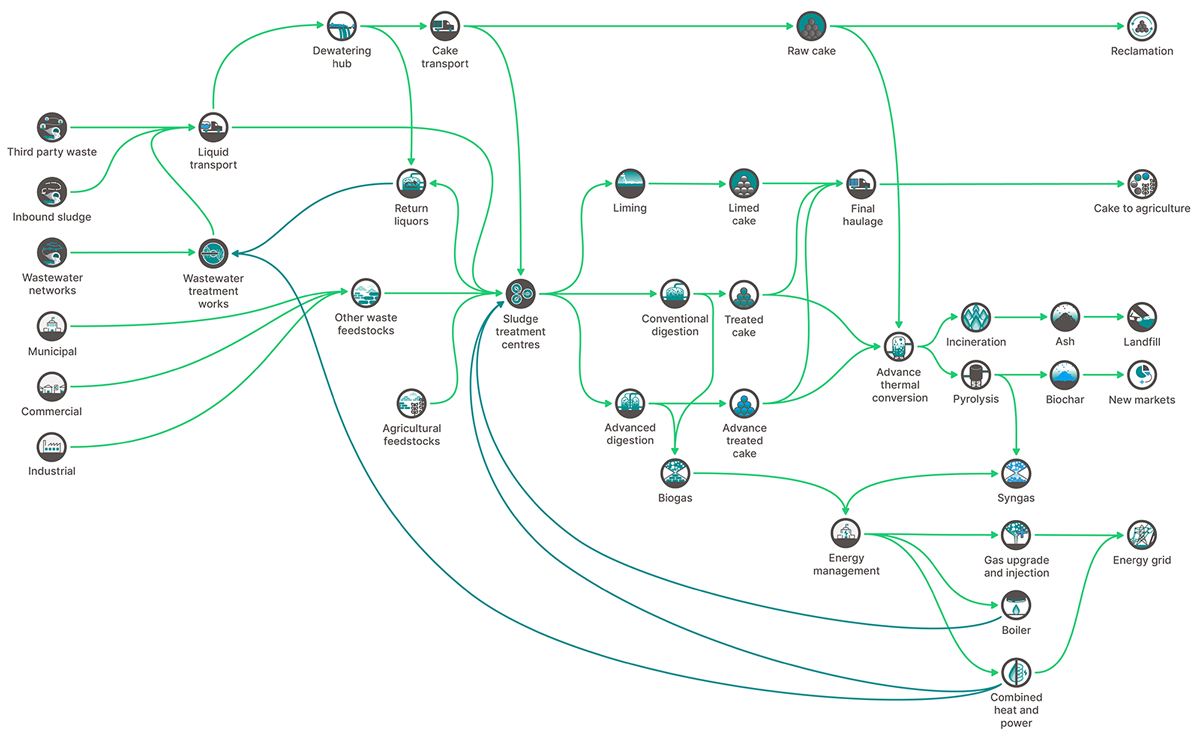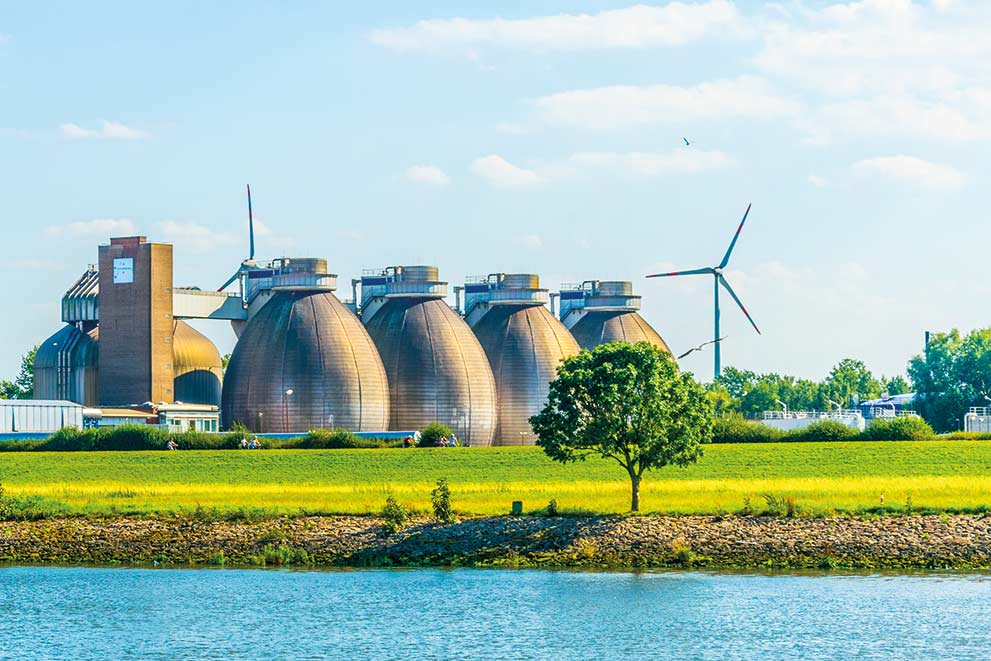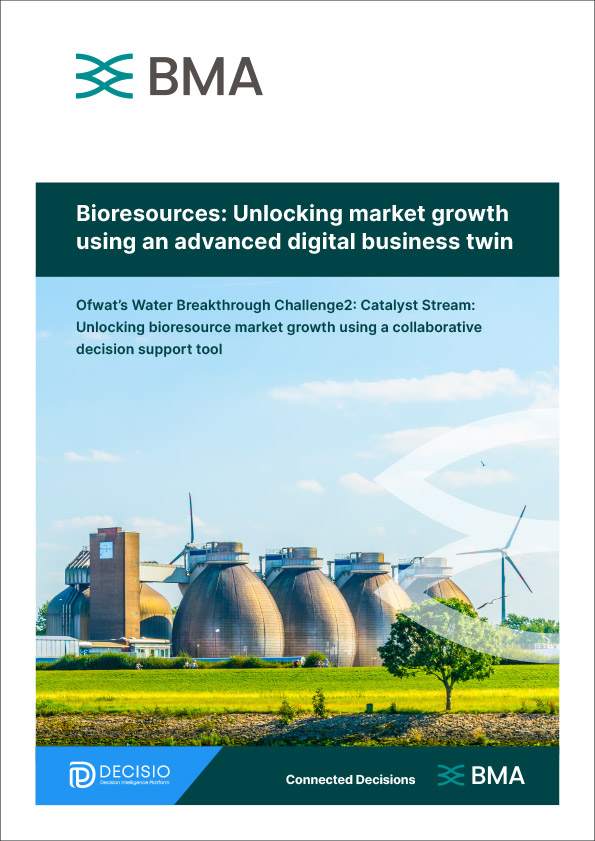Steve Riches
Portfolio Lead Bioresources, Asset Delivery Planning
Anglian Water Services
With the increase in complex challenges such as climate change and population growth, greater certainty is needed around the long-term approach for managing sludge and bioresources to support the delivery of national policies and deliver improved environmental outcomes.
As part of the Ofwat Innovation Fund, BMA partnered with Anglian Water together with four other major utility companies, serving 35 million customers in the UK, to find a way to quickly identify opportunities in the bioresources market and to tackle the challenge of meeting increased capacity requirements. We explored ways we could work in partnerships and fully understand the market opportunities through integrating asset systems and collaborating with neighbouring water companies on potential joint investments.
The evolution of a bioresources market presents a range of opportunities and challenges for wastewater utilities, including overcoming the impact of population growth with its inevitable pressures to meet increased treatment capacity. The task ahead is enormous and requires a more connected, systemic and adaptive decision-making.
Click here to go straight to our interactive dashboard report and read about our approach and key findings.
By removing traditional company constraints and geographic barriers, we were able to harness the real power of systemic planning. Our Digital Business Twin enables a wastewater utility to employ a whole system methodology and adaptive planning functionality to unlock insights and drive significant business benefits in the Bioresources sector.
Asset systems were seamlessly integrated in a single digital representation, thereby creating an opportunity to harness the power of systemic planning. Across the five water companies, the approach identified shared investment and carbon strategies which could not have been achieved through independent planning across the individual companies.
Our solution supports Ofwat’s vision for a whole systems approach to long-term delivery planning that creates efficiencies in the biosolids treatment sector by delivering an in-depth overview of the entire end-to-end sludge value chain from collection, transport, and treatment to end-product biosolids recycling across multiple water company networks.
The five UK water companies determined and aligned asset investment decisions associated with a combined asset base of £1.9 billion and an operating cost of circa 3150m a year. Through this initiative, they now have a shared, robust, evidence based strategic 25-year asset management plan, providing the foundation for a national UK Bioresources Model.
The initiative encompassed over 2,500 wastewater treatment centres, 100 sludge treatment centres, and more than 500,000 decision variables. By calculating an optimal set of options, the project identified areas for collaboration, potential cost savings, and adaptive pathways to generate additional value and overcome future challenges. In this way, we could gain a unified view of the sector to identify the scale of the challenges and the size of the opportunities.

The Bioresources Value Chain
Bioresources - Anglian Water
The project provides important insights into bioresources market opportunities. By creating a system twin across networks, this has provided an evidence-based platform for dialogue and exchange of ideas with other water companies outside of the project, with Ofwat and our environmental regulators.

Steve Riches
Portfolio Lead Bioresources, Asset Delivery Planning
Anglian Water Services
Bioresources - Southern Water
Southern Water will reference the output from this work in the PR24 submission, as it represents an important example of how digital innovation and collaboration can support meeting common environmental challenges for the sector.

Aurelien Perrault
Bioresources Programme Sponsor
Southern Water
Bioresources - Northumbrian Water
This collaborative research project with BMA has helped us better understand how technology and innovation can drive the sector forward.

John Edwards
Technical Policy Manager Bioresources
Northumbrian Water
Bioresources - Thames Water
This project has delivered an excellent innovative Decision Support Tool to assist Thames Water with their medium-and long-term strategic decisions, especially around potential market opportunities with other water companies.

Andrew Hardman
Bioresources Strategy Manager
Thames Water
Bioresources - Yorkshire Water
By leveraging data and digital solutions, we now have a clearer path toward sustainable growth that benefits both our business and the environment.

Ben Raistrick
Bioresources Asset Management Lead
Yorkshire Water


Establishing a foundation of long-term and fully shared collaboration creates a more resilient network to withstand potential future changes and offers significantly greater opportunities
When investments are permitted, the distinction between open and closed networks becomes notably more pronounced, especially in the face of external challenges that impact the network. The effects of scenarios such as the closure of agriculture landbank for product recycling, decreased asset availability, or elevated capital costs all highlight significantly greater opportunities within an open network framework.
Trading between the current networks can reduce capacity constraints
In a scenario devoid of new investments, opening the company borders brings an advantage. This advantage manifests as an increased throughput within digestion facilities and a consequential decrease in lime-treated cake production. Lime-treated cake, employed as the default option when permanent capacity is lacking, becomes less preferable, especially when ample landbank resources are at our disposal.
There are multiple ways to stimulate the bioresources sector to achieve Net Zero
Three approaches were evaluated for driving the sector towards achieving Net Zero. These included testing the carbon penalty, full carbon accounting (costs and benefits) and the biomethane incentive strategies. While the carbon cost strategy did not completely reduce the carbon emissions down to zero, the full carbon scenario successfully attained a carbon-negative status ahead of schedule. The biomethane incentive scenario also achieved carbon-negative state, while maintaining a more economical operational cost compared to the alternatives.
Systemic thinking can improve both the existing network as well as company-centric investment futures
The advantage arises from optimisation within established constraints. The variance in costs stems from improved capacity utilisation, optimised logistics, and the elimination of redundant material handling. It’s important to note that the values presented for the optimised scenario, which accounts for both planned and unplanned downtime events, depict an ideal scenario that is difficult to attain in real-world operations due to the constraints inherent in practical implementation.
The network representation allows a testbed for potential regulatory changes
Closing the agricultural landbank results in a substantial impact. Emissions surge by over two-fold, while the demand for capital inflates by more than six-fold, accompanied by a corresponding escalation in operating costs.
For detailed information about the background to this initiative, the market for Bioresources, and the methodology behind the data, we are making our technology platform accessible for the first time. Please click on the below dashboard, start the Tour, and interact with the data to see adaptive planning in action. A detailed copy of the report is also available to download.
Data was entered into the digital business twin and scenarios were created calculating an optimal solution for each set of inputs. Through these scenarios we identified key areas for collaboration, potential cost savings, and adaptive pathways to generate additional value and overcome future challenges.
Please note that all data used is publicly available.
For detailed information about the background to this initiative, the market for Bioresources, and the methodology behind the data, download our comprehensive 46-page document by entering your details in the short download form.
Get in touch with us here and send us your questions or arrange a call back.
